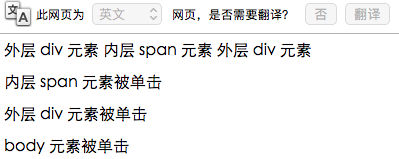假设网页上有两个元素,其中一个元素嵌套在另一个元素中,并且都被绑定了 click 事件,同时 body 元素上也绑定了 click 事件。
<!DOCTYPE html> <html lang="en"> <head> <meta charset="UTF-8"> <title></title> </head> <body> <div id="content"> 外层 div 元素 <span>内层 span 元素</span> 外层 div 元素 </div> <div id="msg"></div> <script src="../../vender/jquery-1.11.3/jquery-1.11.3.js"></script> <script type="text/javascript"> $(function () { $('span').click(function (e) { var txt = $('#msg').html()+"<p>内层 span 元素被单击</p>"; $('#msg').html(txt); }); $('div').click(function () { var txt = $('#msg').html()+"<p>外层 div 元素被单击</p>"; $('#msg').html(txt); }); $('body').click(function () { var txt = $('#msg').html()+"<p>body 元素被单击</p>"; $('#msg').html(txt); }) }) </script> </body> </html>
当单击内部 span 元素,会输出三条记录:

该现象就是由事件冒泡引起的。
元素的 click 事件会按照以下顺序冒泡:
- span
- div
- body
其顺序与事件捕获相反。
停止事件冒泡可以阻止事件中其他对象的事件处理函数被执行,在 jQuery 中提供stopPropagation()方法来停止冒泡。
$('span').click(function (e) { var txt = $('#msg').html()+"<p>内层 span 元素被单击</p>"; $('#msg').html(txt); e.stopPropagation(); });
